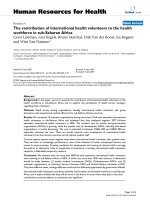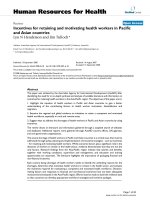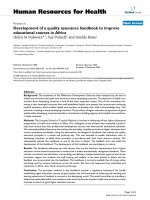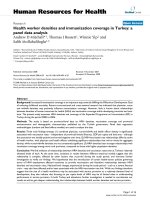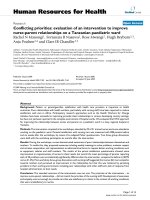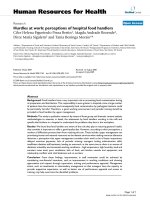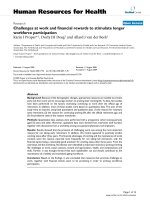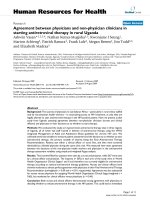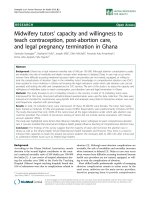báo cáo sinh học:" Challenges at work and financial rewards to stimulate longer workforce participation" doc
Bạn đang xem bản rút gọn của tài liệu. Xem và tải ngay bản đầy đủ của tài liệu tại đây (588.5 KB, 13 trang )
BioMed Central
Page 1 of 13
(page number not for citation purposes)
Human Resources for Health
Open Access
Research
Challenges at work and financial rewards to stimulate longer
workforce participation
Karin I Proper*
1
, Dorly JH Deeg
2
and Allard J van der Beek
1
Address:
1
Department of Public and Occupational Health and EMGO Institute for Health and Care Research, VU University Medical Centre,
Amsterdam, The Netherlands and
2
Department of Psychiatry and EMGO Institute for Health and Care Research, VU University Medical Centre,
Amsterdam, The Netherlands
Email: Karin I Proper* - ; Dorly JH Deeg - ; Allard J van der Beek -
* Corresponding author
Abstract
Background: Because of the demographic changes, appropriate measures are needed to prevent
early exit from work and to encourage workers to prolong their working life. To date, few studies
have been performed on the factors motivating continuing to work after the official age of
retirement. In addition, most of those studies were based on quantitative data. The aims of this
study were to examine, using both quantitative and qualitative data: (1) the reasons for voluntary
early retirement; (2) the reasons for continuing working life after the official retirement age; and
(3) the predictive value of the reasons mentioned.
Methods: Quantitative data analyses were performed with a prospective cohort among persons
aged 55 years and older. Moreover, qualitative data were derived from interviews with workers
together with discussions from a workshop among occupational physicians and employers.
Results: Results showed that the presence of challenging work was among the most important
reasons for not taking early retirement. In addition, this motive appeared to positively predict
working status after three years. The financial advantages of working and the maintenance of social
contacts were the reasons reported most frequently for not taking full retirement, with the
financial aspect being a reasonably good predictor for working status after three years. From the
interviews and the workshop, five themes were identified as important motives to prolong working
life: challenges at work, social contacts, reward and appreciation, health, and competencies and
skills. Further, it was brought forward that each stakeholder can and should contribute to the
maintenance of a healthy and motivated ageing workforce.
Conclusion: Based on the findings, it was concluded that measures that promote challenges at
work, together with financial stimuli, seem to be promising in order to prolong workforce
participation.
Published: 11 August 2009
Human Resources for Health 2009, 7:70 doi:10.1186/1478-4491-7-70
Received: 11 August 2008
Accepted: 11 August 2009
This article is available from: />© 2009 Proper et al; licensee BioMed Central Ltd.
This is an Open Access article distributed under the terms of the Creative Commons Attribution License ( />),
which permits unrestricted use, distribution, and reproduction in any medium, provided the original work is properly cited.
Human Resources for Health 2009, 7:70 />Page 2 of 13
(page number not for citation purposes)
Background
One of the most notable changes in the working popula-
tion is its ageing. The baby boom cohorts born after the
Second World War (born between 1945 and 1965) are
now middle-aged; the oldest of them have already started
retiring. At the same time, lower birth rates in the past few
decades imply that fewer young people will be entering
the labour market [1]. These demographic changes are
bringing about a shift in the ratio of workers to retirees
that will lead to a relative shortage of active workers.
Of the major regions of the world, the process of popula-
tion ageing is most advanced in Europe [2]. The median
age of European Union (EU) citizens will increase
between 2004 and 2050 from 39 to 49 years [3]. After
2010, the year that will mark the greatest number of mem-
bers of the potential working population (i.e. those
between 15 and 64 years), the population of working age
will decline from 331 million to 268 million in 2050 [3].
In contrast, the proportion of people 65 years and older
will increase.
These two demographic changes will result in an increase
in the old-age dependency ratio (i.e. the number of people
over 65 divided by the number of working-age people)
from 25% today to about 53% in 2050 for the 25 EU
countries [3]. At the same time, the share of older workers
(i.e. those between 55 and 64 years) in the total potential
workforce will logically increase. It is estimated that by the
year 2025, between one in five and one in three workers
will be an older worker [2].
It is clear that the demographic shift has serious economic
and social implications, among others the financing of
the social security systems, in that a shrinking number of
economically active people (i.e. workers) will have to pay
for the national pensions of an increasing number of
retired persons. The ageing of the workforce also implies
a change in the human resources (HR) strategies to man-
age age in the workplace. Thus, both government and pri-
vate companies face the challenge of finding means to
prolong the labour participation of (older) workers. This
is especially true since, to date, many older people have
left their jobs either voluntarily (i.e. because of early
retirement) or involuntarily (i.e. because of work disabil-
ity or unemployment) much earlier than the official age of
retirement [4].
As in many countries, the social security system in The
Netherlands used to offer the opportunity of retiring with
a pension before the official retirement age of 65. This so-
called early retirement pension (ERP) was implemented
during a period of widespread unemployment, with the
intention of providing better opportunities for the
younger generation to find jobs. However, due to the pop-
ulation's ageing and its consequences, these early exits
from work are no longer affordable from an economic
point of view. Instead, appropriate measures are needed
to prevent early exit from work and to encourage workers
to prolong their working life.
During the last few years, measures discouraging early
retirement have been implemented in many countries
worldwide. For example, since 2006, ERP is no longer
supported fiscally in the Netherlands, so that voluntary
early exit from work has become more expensive. In other
countries, raising the mandatory retirement age is one of
the measures implemented. It may, however, be ques-
tioned whether such measures imposed by the govern-
ment or the employer are effective. Commitment from the
target group, i.e. the (ageing) workforce, is an important
aspect for successful implementation.
To date, most of the research has focused on the determi-
nants of early exit from work [5,6]. As far as the authors
are aware, there are only limited data as to the motives of
employees for prolonging working life. For example, a
study of Lund and Borg [7] showed that very good self-
rated health and high development possibilities were
independent predictors for remaining at work among
males. Among females, the same two predictors were
found in addition to high decision authority, medium-
level social support and absence of musculoskeletal prob-
lems in the knees [7].
In addition, some other recent studies showed that retire-
ment decisions are influenced not only by the worker's
health status, but also by income levels and pension rights
[8,9]. Those aged 50 and over with poor health, high
income or accumulated wealth and access to occupational
pensions are more likely to retire at the normal retirement
age or retire early [8,9]. Another study showed domestic
and family considerations to be important influences of
retirement behaviour [10]. In contrast, the evidence about
the determinants of involuntary exit from work due to
work disability shows occupational factors to be among
the most important determinants [11,12].
However, the evidence as to the reasons for voluntary
early exit from work is more scarce. From the few previous
studies, it can be concluded that retirement decisions on a
voluntary basis are multidimensional and not driven by
any one single factor. In addition, the little available evi-
dence as to the reasons for voluntary early retirement as
well as for continuing working life is based mostly on
quantitative data. There have been only a few attempts
Human Resources for Health 2009, 7:70 />Page 3 of 13
(page number not for citation purposes)
that involved qualitative data incorporating the worker's
opinions about the factors that motivate them to prolong
their work career after the official age of retirement.
For example, a semistructured interview study among per-
sons who chose early retirement and those who did not,
supported the quantitative finding that decisions about
retirement are not made in a vacuum, but have to do with
diverse types of possible routes into retirement [13]. These
dealt with organisational restructuring, financial offers
and opportunities for leisure and self-fulfilment that early
retirement offers [13].
From a second qualitative study, it appeared that the way
of conceiving work and retirement varied among persons
from different socioeconomic backgrounds [14]. The con-
clusion was that various factors, including financial
imperatives and HR practices, intersect at state pension
age to shape people's routes into retirement and their
options for continuing in work [14].
Finally, most of the previous studies have used cross-sec-
tional data. Hence, the predictive value of the motives to
retire early mentioned by those still working remains
unclear.
Based on the limited literature on the determinants for
prolonging working life, and the scarcity of qualitative
data, the aims of the present study were: (1) to examine
the reasons for voluntary early retirement; (2) to examine
the motives for continuing working life after the official
retirement age; and (3) to examine the predictive value of
the reasons mentioned. A mixed-methods approach was
applied, with quantitative and qualitative data.
Methods
This article describes the results of three studies. The first
study includes data analyses of a prospective study among
persons aged 55 years and older. The second study is
based on qualitative data from interviews with workers,
while the third study includes a workshop among occupa-
tional physicians (OPs) and employers.
Study 1. Quantitative study (LASA)
The aim of this quantitative study was to examine the rea-
sons for voluntary early retirement (first study aim) as
well as the reasons not to voluntarily retire early. Moreo-
ver, with the data of both baseline and follow-up (i.e.
three years later), the predictive value of the motives
stated at baseline was determined (third aim).
Study sample
The first study sample consisted of participants of the Lon-
gitudinal Aging Study Amsterdam (LASA). LASA is an
ongoing, multidisciplinary, cohort study among persons
aged 55 and over. It focuses primarily on the predictors
and consequences of changes in older persons' physical,
cognitive, emotional and social functioning.
The sampling and data collection procedures and the
response rates were described in detail elsewhere [15,16].
In summary, LASA started with data collection in 1992–
1993. A random sample of persons aged 55 years and over
(birth years between 1908 and 1937), stratified by age,
sex, urbanisation grade and expected five-year mortality
was drawn from the population registers of 11 municipal-
ities in three regions in The Netherlands. This procedure
led to a representative sample of the Dutch older popula-
tion, reflecting the national distribution of urbanisation
and population density.
In 2002–2003, a second sample of men and women aged
55 to 64 years was drawn with the same sampling frame
as the original cohort. The 2002–2003 sample is the sam-
ple for the current study, comprising 1002 participants
aged 55–64 years (response rate 57%). In 2005–2006, a
follow-up measurement of the second cohort took place
(n = 908).
Written informed consent was obtained from all partici-
pants. The study was approved by the Medical Ethics
Committee of the VU University Medical Centre.
Interviews
The interviews were held at the respondents' residences
and were conducted by trained interviewers, who used
laptop computers for data entry. The structured interview
covered a wide range of topics related to physical and cog-
nitive health and social and psychological functioning.
For the purpose of the present study, the interview also
included questions on reasons for considering early retire-
ment.
The respondents were asked several questions as to their
working status. Questions relevant to this study were: (1)
Are you currently working in a paid job? (yes; no); (2) Are
you currently (partially) work-disabled? (yes; no); (3)
Have you already taken (partial) early retirement? (yes,
completely; yes, in part; no); and (4) Would you consider
taking (partial) early retirement if financially possible?
(yes; no). Partial early retirement refers to working fewer
hours in the main occupation.
To get insight into the reasons for voluntary early retire-
ment as well as the reasons not to voluntarily retire early,
respondents were asked their most important reason: (1)
to take (partial) early retirement; (2) not to take full early
retirement; (3) not to take early retirement at all; and (4)
(among those who had already taken (partial) early retire-
ment) to have taken (partial) early retirement. All four
Human Resources for Health 2009, 7:70 />Page 4 of 13
(page number not for citation purposes)
questions included branching questions that were asked
to subgroups according to the working status and the con-
sideration to take (partial) early retirement (Figure 1). The
first two questions were asked of those with a paid job,
who had not already taken early retirement, but who were
considering taking early retirement, whereas the third
question was asked of those with a paid job, who had not
already taken full retirement and who were not consider-
ing taking early retirement. For each of these questions,
the last of the five or seven answer categories included
"another reason" than mentioned, leaving respondents
space to fill in their own reason.
Analysis
For the purposes of this study, descriptive analyses were
conducted. A frequency table was produced for each of the
four questions (see above) indicating the percentage of
each reason specified. The "other reason" category was
analysed in more detail; answers that could be clustered
were grouped. The predictive value of the reasons reported
was determined by a frequency table of the working status
(i.e. working or having retired) at follow-up per reason
mentioned at baseline. Analyses were performed using
SPSS software, version 14.0 for Windows.
Both Study 2 and Study 3 were performed to get insight
into the motivating factors for continuing to work and the
measures that can be taken to stimulate prolonging work-
ing life.
Study 2. Interviews with workers
Study sample
Workers were recruited by the occupational health service
(OHS) that participated in this study. By means of its cus-
tomer database, the OHS approached 12 companies that
differed in sector and size. Four companies agreed to par-
ticipate. These four companies were from different sectors
and included: (1) local government, (2) youth- and
health care, (3) outdoor advertising and (4) an OHS,
located in another city than the one involved in the
recruitment in this study. The companies also varied in
size (from approximately 60 to 700 workers), job charac-
teristics and workers' educational level.
Flow diagram of the LASA respondents regarding working and retirement statusFigure 1
Flow diagram of the LASA respondents regarding working and retirement status.
LASA respondents
Have a paid job?
n=999
No
n=578
Have taken early retirement?
Yes
n=421
Yes, completely
n=24
Yes, partly
n=17
No
n=377
No
n=373
Yes, partly
n=13
Yes, completely
n=155
Consider to take early retirement?
No
n=137
Yes
n=235
- Most important reason not to take early retirement at all
(n=136)
Missing value
n=3
Missing value
n=5
Missing value
n=37
- Most important reason to take (partial) early retirement (n=234)
- Most important reason not to take full early retirement (n=221)
Human Resources for Health 2009, 7:70 />Page 5 of 13
(page number not for citation purposes)
Within each company, the aim was to interview two work-
ers individually and to hold one focus group interview
with approximately five to 10 workers. Selection of the
workers was done by a member of the HR staff or the head
of the department, and was based on socioeconomic fac-
tors (e.g. sex, age, job position), availability and willing-
ness to volunteer, to capture a broad range of
characteristics. The workers were approached primarily
face-to-face by their HR staff or supervisor to participate in
the interviews. After agreement, the researcher arranged a
specific date and time for the interviews.
Interviews
For the purposes of this study, semistructured interviews
were held. Semistructured interviews define the area to be
explored, at least initially, and allow the interviewer or the
interviewee to diverge in order to pursue an idea in more
detail [17]. This strategy encourages open answers,
thereby eliciting new, additional information. During the
interview, the interviewer tried to be interactive and to
uncover factors that were not anticipated at the outset of
the interview.
After briefly introducing the study and asking a few gen-
eral questions, the interview guide posed the following
questions: (1) "Are you willing to continue working until
or after the age of 65?" (2) "What are factors that motivate
you to continue working?" (3) "What measures can or
should be taken to prolong your work career?"
All interviews took place face-to-face and were recorded
on a digital voice recorder. The focus group interviews
lasted approximately 50 minutes; the duration of the indi-
vidual interviews varied from 24 to 42 minutes. During
the interviews, the interviewer took field notes. The inter-
views were held in a meeting room at the company and
were conducted by the principal researcher (KP).
Analysis
The interviews were fully transcribed by an assistant. Sub-
sequently, content analysis was conducted by the princi-
pal researcher to analyse the transcripts. First, the
transcripts were read and reread to become familiar with
the text. Next, the text was marked with codes indicating
the content of the response. The codes were then grouped
together into key themes. In the Results section, interview-
ees' quotations that were considered representative for the
theme are reported in order to illustrate the meaning of
the themes.
Study 3. Workshop with occupational physicians (OP) and
employers
OPs and employers
To compare the views of the workers with the opinions of
important stakeholders, a two-hour workshop among
OPs and employers was held. The workshop was organ-
ised within a general course for OPs by their occupational
health service (OHS). As the workshop fit well in the pro-
gramme, it was decided to incorporate the workshop in
the OHS's OP course. In total, 20 OPs participated in the
course, including the workshop. In addition, five repre-
sentatives (human resource management (HRM) staff) of
the four participating companies joined during the work-
shop.
Workshop
The workshop started with a 30-minute presentation by
the principal researcher about the study and the results of
the interviews among the workers. Subsequently, four
working groups were formed, each consisting of one or
two representatives of each company and five OPs.
For one hour, each working group discussed two issues.
First, they discussed the motivating factors mentioned by
the workers. In their discussion, the OPs and employers
were encouraged to add motivating factors. The second
issue discussed in the working group concerned the meas-
ures to be taken by the employer or the OHS that might
stimulate workers to prolong their participation in the
workforce. Each working group was asked to write down
its views, and one person within each group was asked to
report on these in the plenary session. In the plenary ses-
sion, per working group, the workshop leader (KP) wrote
down all views of each working group on a flip chart and
gathered the papers of each working group.
Analysis
After the workshop, the views reported on the flip chart
and the working groups' papers were copied by the
researcher in an electronic form on a computer. The work-
shop notes were coded according to the themes identified
by the interviews with workers. Similar to the analysis of
the interviews (Study 2), the text was marked with codes
and then grouped together into themes.
Results
Study 1
Table 1 shows the working status of the study population
at baseline. A small majority (57.9%) did not have a paid
job (any longer) at the moment of baseline measurement,
and about a quarter of the respondents (23%) were work-
disabled. The large majority (78.2%) had not taken early
retirement. Of those currently working (n = 421), almost
two thirds (63.2%) reported they were considering taking
(partial) early retirement (Table 1). Further, among those
with a paid job, n = 377 were not yet partially retired early
(Figure 1).
Table 2 presents the frequencies of the workers' most
important reasons not to take (full) early retirement.
From this table, it can be concluded that the reasons for
not taking early retirement at all are different from the rea-
Human Resources for Health 2009, 7:70 />Page 6 of 13
(page number not for citation purposes)
sons for not taking full early retirement. Having sufficient
challenges at work appeared to be by far (59.6%) the most
important reason for workers not to take early retirement,
whereas the financial aspect (32.6%) and the social con-
tacts (25.3%) were reported most frequently as the most
important reasons not to take full early retirement (Table
2).
Table 3 presents the predictive value of the reasons men-
tioned for work status at three-year follow-up. It appeared
that the majority of those who reported challenges at
work as the most important reason not to take (full) early
retirement, were indeed still working three years later
(84.4% and 66.7%) (Table 3). With respect to the finan-
cial advantages as the most important reason not to take
full early retirement, it appeared that three years later,
68.3% were indeed still working or partly retired, but a
quarter (24.2%) had taken full retirement. The mainte-
nance of social contacts had less predictive value, since
one third (35.4%) of those who reported social contacts
as the most important reason not to take full retirement,
had taken full retirement in the meantime.
Table 4 describes the most important reasons for taking
early retirement among workers as well as among those
who had retired early. Among the workers, the pleasure of
spending more time on private concerns was by far the
most important reason to take early retirement (59.4%).
This reason was also reported most frequently by those
who had already taken (partial) early retirement (27.3%)
(Table 4). Further, among those who had taken early
retirement, external factors, such as arrangements that
Table 1: Working status of the study sample (LASA cohort
2002–2003) at baseline
% (n)
Have a paid job n = 999
No 57.9% (578)
Yes 42.1% (421)
Have a (partly) work disability n = 961
1
No 77% (740)
Yes 23% (221)
Have taken early retirement n = 960
1
No 78.2% (751)
Yes, partly 3.1% (30)
Yes, completely 18.6% (179)
Consider taking early retirement n = 372
2
No 36.8% (137)
Yes 63.2% (235)
1
Due to missing values, the number of respondents is not equal to
999.
2
This question was asked of those currently working and not having
taken early retirement.
Table 2: Frequency of most important reason not to take (full) early retirement
Most important reason not to take early
retirement
1
Most important reason not to take full
early retirement
2
Most important reason reported at baseline % (n) % (n)
Sufficient challenges at work 59.6 (81) 18.1 (40)
Maintain social contacts 17.6 (24) 25.3 (56)
Other pastime less pleasant 0.7 (1) 1.8 (4)
Financially more favourable 5.9 (8) 32.6 (72)
Other reason 16.2 (22) 22.2 (49)
100% (136) 100% (221)
1
This question was asked of those with a paid job, who had not taken early retirement, and who were not considering taking early retirement.
2
This question was asked of those with a paid job, who had not taken early retirement, but who were considering taking early retirement.
Human Resources for Health 2009, 7:70 />Page 7 of 13
(page number not for citation purposes)
Table 3: Working status at follow-up per reason not to take (full) early retirement as reported at baseline
Working status at follow-up per reason not to
take early retirement
Working status at follow-up per reason not to take full early
retirement
working partly/fully
retired early
disabled working partly retired
early
fully retired
early
disabled
Reason reported
at baseline
% (n) % (n) % (n) % (n) % (n) % (n) % (n)
Enough
challenges at
work
84.8 (56) 7.6 (5) 7.6 (5) 66.7 (20) 5.9 (2) 11.8 (4) 13.1 (4)
Maintain social
contacts
80 (12) 0 (0) 20 (3) 32.5 (13) 10.4 (5) 35.4 (17) 17.5 (7)
Other pastime
less pleasant
100 (1) 0 (0) 0 (0) 66.7 (2) 0 (0) 25 (1) 33.3 (1)
Financially more
favourable
66.7 (4) 16.6 (1) 16.6 (1) 63.8 (37) 4.5 (3) 24.2 (16) 8.6 (5)
Other reason 84.6 (11) 7.7 (1) 7.7 (1) 46.3 (19) 8.9 (4) 33.3 (15) 9.8 (4)
Total n = 84 n = 7 n = 10 n = 91 n = 14 n = 53 n = 21
Table 4: Frequency table of most important reason to take (full or partial) early retirement
Workers
1
Early retirees
2
Most important reason reported at baseline % (n) % (n)
Stress and pressure of work too high 9.8 (23) 6.3 (13)
Physically too heavy 6.8 (16) 5.4 (11)
Health complaints too limiting 6.8 (16) 6.3 (13)
Not motivated anymore 2.1 (5) 5.9 (12)
Nicer to spend more time on private life 59.4 (139) 27.3 (56)
Not possible anymore in the future 1.7 (4) 5.4 (11)
Having worked for many years
3
2.1 (5) -
Organisational changes in company
3
2.6 (6) 9.8 (20)
Arrangements that made early retirement attractive
3
- 14.6 (30)
Other reason 8.5 (20) 19.0 (39)
100% (234) 100% (205)
1
This group included those with a paid job, who had not taken early retirement, but who were considering taking early retirement.
2
This group included those who have already taken (partial) early retirement.
3
This category was formed after clustering the answers of "other".
Human Resources for Health 2009, 7:70 />Page 8 of 13
(page number not for citation purposes)
made early retirement attractive and organisational
changes, were also reported frequently as the most impor-
tant reason to have taken early retirement. Health com-
plaints as well as (physical or mental) workload were
reported by a only small minority of the workers and reti-
rees (<10%) (Table 4). Although the pleasure of spending
more time on private pursuits was reported frequently as
the most important reason to take early retirement, the
majority (65.7%) were still working at follow-up (data
not shown).
Study 2
Interviews with workers
Thirty workers were interviewed, either individually or in
focus groups. With the exception of the local authority,
within each company two interviews were held, each with
one worker, as well as one focus group interview with five
to eight workers. At the local authority, it was not possible
to hold a focus group interview; instead, five workers were
interviewed individually. Thus, a total of 11 individual
interviews (six men, five women) and three focus group
interviews were held among 19 workers (nine men, 10
women) aged 30 to 59 years.
Although the questions in Study 1 differ from those in the
qualitative study (i.e. questions related to the reasons
either to take or not to take early retirement versus the
motivating factors to continue working), the results were
rather similar. In line with the LASA results, where only
about one third of those currently working were not con-
sidering taking early retirement, it appeared from the
interviews that most workers were not willing to continue
working after the age of 65 years. Although the majority of
the interviewees indicated that they were still motivated to
work, that they liked their job and that they (still) were
healthy enough to perform their job, they did not intend
to prolong their working life.
Furthermore, the major reasons (i.e. sufficient challenges
at work, maintenance of social contacts and the financial
aspect) reported by the LASA respondents for not taking
(full) early retirement were also expressed by the inter-
viewees as motivating factors to continue working. From
the responses of the interviews, five key themes were iden-
tified: (1) challenges at work, (2) social contacts, (3)
reward and appreciation, (4) health and (5) competencies
and skills (Table 5). The themes include predominantly
motivating factors, but also point to measures that can be
taken to stimulate a sustained employability.
Challenges at work
Most of the interviewees considered the content of their
job of importance to continuing to work. They indicated
that they liked their job, were motivated by their work and
that they needed their work. With the exception of the
workers who performed a physically heavy job, which
included routine, it was frequently indicated that they per-
Table 5: Working status at follow-up per reason not to take (full) early retirement as reported at baseline
Themes Motivating factors
Challenges at work - Work climate is important
- Being needed, feel oneself useful
- Commitment to work and company
- Work should be challenging and give satisfaction
- Deliver a quality product
Social contacts - Social contacts
- Socially active
Reward and appreciation - Financial compensation or reward at the sort term
- Appreciation for the work done (by giving compliments)
Health - Prevention of work strain (physically and mentally)
- Healthy lifestyle
- Optimal balance between work load and capacity
Competencies and skills - Moving possibilities within company (horizontal and vertical)
- Variation in tasks
- Career support
- Education and training
- Coaching role for older worker
- Retraining, occupational resettlement
Human Resources for Health 2009, 7:70 />Page 9 of 13
(page number not for citation purposes)
ceived a feeling of satisfaction and motivation when they
were being challenged.
By nature, I am rather lazy, but I am challenged by my
work. Being at work, I become challenged intellectu-
ally; without work, there is no interesting life for me."
"So far, I am not ready to stop. I am motivated to
work, to continue work, because the job is challenging
enough."
Social contacts
Without exception, all workers interviewed appeared to
set great store on the contact with colleagues and the asso-
ciated work climate. One worker, for example, expressed
this motive as: "Work is both intellectual and social food."
Another worker reported: "It can be that your 'world will
become so narrow' yes, the contact with colleagues and
clients is very important."
Reward and appreciationMost of the interviewees highly
valued appreciation from others for the work they did,
and considered it as an important factor in continuing.
This motive referred to both the financial aspect and
reward expressed in words by the supervisor or colleagues.
Although none of the interviewees indicated the financial
reward as the most important reason to continue working,
they agreed that "it definitely plays a role". One worker
said: "Respect and appreciation, that's what I think is
important."
As to the pat on the back (by the boss) as a motivating fac-
tor, they valued receiving a compliment from either the
supervisor or colleagues. For example, one worker said:
"I absolutely think reward is essential in remaining
motivated to perform the job. This can be through a
bonus, but also by your colleagues who say to you
how well you performed the task, or by having a din-
ner together, or something like that."
Health
In the company providing outdoor advertising, the inter-
viewees performed heavy, physical jobs. These workers
generally had a negative attitude about prolonged partici-
pation in the workforce. One reason for this negative atti-
tude was associated with the total years of having worked
when they reached the age of 65 years, since they had
started working when quite young. Another reason for
their negative attitude concerned the expectation that they
would not be able to continue their (current) work, due to
the heavy physical workload. Because of their workload,
these workers suggested using tools that would reduce the
physical work in order to be able to prolong participation
in the workforce.
In the remaining three companies, physical workload was
not the issue, in contrast to mental workload. Especially in
the OHS, workers experienced (too) high work demands.
To reduce or cope with work-related stress, some workers
suggested implementing a relaxation programme or creat-
ing possibilities for relaxation, e.g. by means of a room
where workers could rest, or through implementation of a
yoga programme.
The promotion of a healthy lifestyle, including physical
activity and diet, was also mentioned frequently as being
an important factor for increasing the capacity and moti-
vation to prolong a healthy working life. Although they
generally agreed that a healthy lifestyle was the worker's
own responsibility, they also agreed on the role of the
employer in stimulating as well as facilitating such a life-
style.
"I need to take care that I stay healthy; that's my own
responsibility."
Competences and skills
Finally, the interviewees agreed on the value of education
and training of (older) workers to be able to keep up with
technological developments. They also reported that
training or education was valuable and should be offered
by the employer in order to grow (personally), to stimu-
late challenges at work and to avoid routine work.
"One needs to develop oneself; as soon as the job
becomes a routine, it's not good, and one will not
remain motivated."
It was further suggested to include the competences and
personal development in the functioning discussions:
"In my opinion, the personal development should be
included in the yearly functioning discussion."
There were no substantial differences in factors stated by
younger and older workers. It appeared only that younger
workers had difficulties in describing factors that would
motivate them to prolong their working life, as "it is such
a long way off".
Study 3
Workshop with OPs and employers
The OPs and employers generally agreed with the workers'
opinions expressed in the interviews. No additional fac-
tors were mentioned by them.
As to possible measures to be taken by the employer or the
OHS to prolong workers' participation in the workforce,
the working groups generally agreed with each other and
reported more or less the same measures. From the notes,
Human Resources for Health 2009, 7:70 />Page 10 of 13
(page number not for citation purposes)
the following main themes were identified: (1) health
promotion, (2) education and training and (3) financial
stimuli.
Health promotion
Each working group independently reported factors that
involved promoting the balance between workload and
individual capacity, the latter receiving a notable amount
of emphasis. The workshop participants not only referred
to the promotion of physical activity and exercise, but also
emphasised the role of a healthy diet, quitting smoking, a
moderate consumption of alcohol and relaxation. Similar
to the workers, they agreed on the responsibility of the
worker, but also considered the role of the OP and the
employer. One working group said, for example:
"It is of importance to stay fit and healthy; this is the
responsibility of the worker. The employer, on the
other hand, should give the good example. There
should be attention for a healthy lifestyle within the
organisation."
Another working group expressed its opinion about this
issue as follows:
"The employer will do right if he implements a 'vitality
policy' including physical activity, fitness, walking in
lunchtime or walking during meetings. In most cases,
the corporate culture needs to be changed in that it
promotes health management with even more strin-
gent measures when neglecting certain activities."
In addition to offering lifestyle programmes and provid-
ing information, they considered a periodic health screen-
ing to be a useful OHS tool, since the results of such a
screening can give direct cause to providing (lifestyle)
counselling. With respect to the other side of the balance,
i.e. the workload, all agreed that this should be tuned to
individual capacity.
Education and training
The working groups stated that work should be fun and
offer sufficient challenges. This could, for example, be
achieved by making plans about the work career and edu-
cation needed and to be followed. Education and training
should also be promoted, as it created variation in work,
the latter being an important boost to taking pleasure in
work. To achieve variation in work, some in the working
groups suggested exchanging workers from different com-
panies, or to give older workers a coaching or mentor task
in orienting new colleagues.
To illustrate, one working group indicated:
"It is of crucial importance that one enjoys the job!
This can be realised by several measures – among oth-
ers, by giving older workers a coaching task in which
they train young workers; the employer can also make
agreements with the (older) worker about career plan-
ning."
Financial stimuli
Consistent with the interviews among the workers, atten-
tion was paid to the financial aspect. The OPs and
employers agreed on the desirability of having both the
employer and the government provide financial stimuli to
workers who prolonged their working life. Moreover, they
advocated maintaining the same net salary when demot-
ing workers because of a (age-related) reduction in work
ability.
Discussion
The aim of this study was to examine the reasons for vol-
untary early retirement as well as for prolonging working
life after the official retirement age. Insight into these
motives is useful, among other reasons, as input to the
HRM policy to retain healthy (older) workers who are
able and willing to prolong their labour force participa-
tion. Despite the need to tailor the HRM policy to the
needs and preferences of older workers [18], it should be
kept in mind that older workers are a heterogeneous
group in that differences exist in personal characteristics,
needs and work ability between individual workers. This
was confirmed by the OPs and employers in the present
qualitative study, in that they stated that the workload
should be tuned to individual capacity.
From the LASA analyses, it was shown that, of those cur-
rently working, about two thirds were considering taking
early retirement. In view of the economic need to prevent
early exit from work, this proportion is substantial. As
mentioned before, it is important to encourage workers
not to take early retirement, but to prolong working life
instead. In order to achieve this, workers should be able as
well as be motivated to continue working.
Indeed, the most important reason given by the LASA
respondents currently working for not taking early retire-
ment appeared to be the motivation to perform the job,
i.e. the presence of challenge at work. This was supported
by the interviews among the workers, where pleasure at
work was mentioned frequently as a motive to prolong
working life. Based on the LASA follow-up data, it
appeared that the presence of sufficient challenges at work
positively predicted the working status three years later.
That is, the majority of workers who found their work
challenging, and indicated this was an important reason
Human Resources for Health 2009, 7:70 />Page 11 of 13
(page number not for citation purposes)
not to take early retirement, actually remained in the
workforce.
Another notable result of this study concerned the fact
that the reasons for not taking full early retirement dif-
fered from the reasons not to take early retirement (at all).
Based on the LASA analyses, the main reasons for the
former were the financial aspect of working and the main-
tenance of social contacts. The social aspects, but particu-
larly the financial advantages of working, thus seemed to
play an important role in the decision to either fully retire
or to cut down work gradually by partial early retirement.
Again, these results were confirmed by the qualitative
study. The large majority of the workers interviewed said
the social contacts with colleagues and others at work
were of great importance to work motivation. However,
based on the LASA follow-up data, it appeared that the
maintenance of social contacts had a weak predictive
value for the working status three years later. A substantial
part of those who had reported social contacts being the
most important reason not to take full retirement, did
take full retirement in the meantime.
As to the financial aspect, both the workers interviewed
and the OPs and employers agreed on its significance. In
addition, the financial advantage of not taking retirement
appeared to reasonably predict the working status three
years later.
Based on these findings, including the desire of the major-
ity of workers to take early retirement, it seems sensible to
aim for a gradual exit from work through a period of
working fewer hours in order to prevent full early retire-
ment. In this way, the workers benefit financially and
moreover can spend some more time on private pursuits,
this being the most important reason to take early retire-
ment, as shown by the LASA analyses. This was confirmed
by a recent study by Cebulla et al. [19], which stated that
there is broad consensus that older workers should be
given the opportunity to retire gradually.
Another study found control over the retirement decision
to be an important factor in retirement well-being, which
persisted three years after retirement [20]. They also found
that gradual retirement was followed by a positive change
in health. Gradual retirement was linked to an improve-
ment in health. According to the authors of that study,
those findings suggest that HR practices that promote
employees' control of their retirement decisions will
enhance well-being in later life and facilitate prolonged
workforce participation [20].
As mentioned in the introduction, not much literature has
been published as to the reasons for voluntary early exit
from work or for an enduring working life. However, the
few previous studies performed in different countries sup-
port our results.
For example, Armstrong-Stassen (2006) investigated the
importance of six HRM strategies relevant in the retention
of older workers [21]. These six factors were: (1) flexible
working options, (2) training and development, (3) job
design (e.g. reduce workload), (4) recognition and
respect, (5) performance evaluation and (6) compensa-
tion (e.g. financial, incentives). Although different terms
have been used in Table 5, most of the five strategies, if
not all, are reflected.
From Armstrong-Stassen's study, it appeared that both
retired and employed men rated three HRM practices the
same as to their influence on the decision to remain in the
workforce: (1) providing challenging and meaningful job
tasks; (2) recognising experience, knowledge and skills;
and (3) showing appreciation for doing a good job [21].
Further, data from a representative sample of the house-
hold population aged 50 and over in England, the English
Longitudinal Study of Ageing (ELSA), confirm that influ-
ences on retirement are multidimensional, with economic
incentives being an important, if not the most important,
determinant for continuing working life [22].
Two other factors of influence appeared to be health and
social issues. As to the financial aspect as a determinant of
retirement behaviour, the literature is consistent [23].
Using ELSA data, Banks et al. (2007) found that both pen-
sion accrual and pension wealth are important determi-
nants of the retirement behaviour of men aged 50 to 59.
This was also valid among women of the same age,
although it was somewhat weaker [24]. It further
appeared that there was a U-shaped pattern of being in
paid work by quintile of the wealth distribution, with
those at the bottom and the top of the wealth distribution
being less likely to be in paid work than those in the mid-
dle of the wealth distribution, but for different stated rea-
sons: those with relatively low levels of wealth were most
likely to stop working due to ill health [24]. Thus, ELSA
showed that financial need may act as an incentive to con-
tinue working life, but that this varies with wealth, income
and education levels [25].
Strengths and limitations of the study
As mentioned before, the few previous studies regarding
the reasons for early retirement and prolonging working
life have mostly used quantitative research methods. One
of the strengths of the present study is that it is based on
mixed methods, with both quantitative and qualitative
data. Such a triangulation method is useful as it
approaches the same phenomenon by using different
methods, each having its own value. Qualitative research
techniques add vast amounts of relevant data [26].
Human Resources for Health 2009, 7:70 />Page 12 of 13
(page number not for citation purposes)
There were, however, some limitations in our qualitative
study. Although the transcripts were made by an assistant,
the interviews were performed by one researcher, as were
the analyses of the responses into codes and themes. Fur-
ther, despite our not believing that it introduces bias, we
did not use a computer software programme in which
each item is compared with the rest of the data to establish
analytical categories [26]. Instead, the interviewer herself
read and reread the recordings, identified the codes and
grouped the codes together into key themes. The analyses
were performed manually, which was feasible and accept-
able, instead of by means of a software package specifi-
cally designed for qualitative data management. Although
the latter would have made the process easier, we assumed
the chance to be small that the manual process would
have yielded substantially different clusters. However, as
is the case in all qualitative studies, the categorisation of
the themes depended on the human factor (i.e. the
researcher), and might well have resulted in different clus-
ters if the process had been performed by another
researcher.
Another strength of this study is that the quantitative
study involved a longitudinal study among a representa-
tive sample of older adults in The Netherlands. The LASA
follow-up data were useful to provide information about
the predictive value of the motives reported at baseline to
take (or not) early retirement. Overall, results indicated
that the motives reported did not have a high predictive
value. However, considering the small number of follow-
up data used, prudence is needed for the conclusions as to
the predictive value of the reasons mentioned. In this
respect, it is also worthwhile to mention that the present
study can be considered as a pilot study in that it is based
on data of Dutch workers only. As the topic of ageing
workers is of worldwide interest, a future study involving
diverse countries with diverse policies to encourage a sus-
tained participation in the workforce would be valuable.
Finally, although the involvement of different stakehold-
ers in the qualitative study added value to the study in that
extra input could be generated instead of involving only
one target group, the number of the representatives of
companies was low. Nevertheless, the inclusion of the
four companies, which included different in type of work-
ers and work activities, yielded useful information about
the organisation of the (HRM) policy with respect to the
promotion of an enduring participation in the workforce
of older workers.
Conclusion
Taken together, findings suggest that each stakeholder
(i.e. the worker, the employer, the OHS and the govern-
ment) should contribute to the maintenance of a healthy
and motivated ageing workforce. In doing so, one should
take into account the differences in strategies for different
groups, such as different socioeconomic status groups or
those at different ages. Due to the small size of the study,
and especially the qualitative study, the present study
could not draw such conclusions for different subgroups.
So, further research examining the motivating factors to
prolong working life among different groups is recom-
mended.
In addition to their ability to work, workers' motivation is
considered to be crucial in sustaining participation in the
workforce. Workers who lack pleasure at work and are not
motivated to prolong their working life, probably confirm
the negative image of some employers about older work-
ers, i.e. lower productivity and "waiting out one's time".
There are still some employers for whom the negative
effects of ageing prevail over the value of older workers, in
that older workers are less productive or resist change or
innovations. In order to oppose this view, the employer
can and should implement simple measures, such as
offering education and expressing appreciation to the per-
sonnel. Finally, measures that promote challenges at
work, together with financial stimuli, seem to be promis-
ing in keeping older workers in the workforce.
Competing interests
The authors declare that they have no competing interests.
Authors' contributions
All three authors made a substantial contribution in the
design of this specific study. DD was (and still is) involved
and responsible for the design and data collection of the
quantitative study (Study 1). KP and AvdB were involved
in the design and the acquisition of the qualitative data
(Study 2). KP performed the statistical analyses. All three
authors read and approved the final manuscript for sub-
mission to this journal.
References
1. Griffiths A: Ageing, health and productivity: a challenge for
the new millennium. Work & Stress 1997, 11:197-214.
2. Van Nimwegen N: Europe at the Crossroads: Demographic Developments
in the European Union. Executive Summary, European Observatory on the
Social Situation, Demography Monitor 2006 – European Observatory and
the Social Situation – Demography Network Brussels: European Com-
mission; 2006.
3. European Commission: Directorate-General for Employment,
Social Affairs and Equal Opportunities Unit E.1. In Europe's
Demographic Future: Facts and Figures on Challenges and Opportunities
Luxembourg: Office for Official Publications of the European Com-
munities; 2007.
4. Van Nimwegen N, Beets G: Social Situation Observatory. Demography
Monitor 2005. Demographic Trends, Socio-Economic Impacts and Policy
Implications in the European Union The Hague: Netherlands Interdisci-
plinary Demographic Institute; 2006.
5. Humphrey A, Costigan P, Pickering K, Stratford N, Barnes M: Factors
Affecting the Labour Market Participation of Older Workers. DWP
Research Report 2000 Leeds, West Yorkshire: Corporate Document
Services; 2003.
6. Meadows P: Retirement Ages in the UK: A Review of the Literature.
Employment Relations Research Series No. 18 London: Department of
Trade and Industry; 2003.
Publish with BioMed Central and every
scientist can read your work free of charge
"BioMed Central will be the most significant development for
disseminating the results of biomedical research in our lifetime."
Sir Paul Nurse, Cancer Research UK
Your research papers will be:
available free of charge to the entire biomedical community
peer reviewed and published immediately upon acceptance
cited in PubMed and archived on PubMed Central
yours — you keep the copyright
Submit your manuscript here:
/>BioMedcentral
Human Resources for Health 2009, 7:70 />Page 13 of 13
(page number not for citation purposes)
7. Lund T, Borg V: Work environment and self-rated health as
predictors of remaining in work 5 years later among Danish
employees 35–59 years of age. Exp Aging Res 1999, 25:429-434.
8. Emmerson C, Tetlow G: Labour market transitions. In Retire-
ment, Health and Relationships of the Older Population in England: The
2004 English Longitudinal Study of Ageing (Wave 2) Edited by: Banks J,
Breeze E, Lessof C, Nazroo J. London: Institute for Fiscal Studies;
2006:41-63.
9. Philipson C, Smith A: Extending Working Life: A Review of the Research
Literature. DWP Research Report 299 Leeds, West Yorkshore: Corpo-
rate Document Services; 2005.
10. Vickerstaff S, Cox J, Keen L: Employers and the management of
retirement. Soc Policy Admin 2003, 37:271-287.
11. Krause N, Dasinger LK, Deegan LJ, Brand RJ, Rudolph L: Psychoso-
cial job factors and return to work after compensated low
back injury: a disability phase-specific analysis. Am J Industr
Med 2001, 40:374-392.
12. Dasinger LK, Krause N, Deegan LJ, Brand JB, Rudolph L: Physical
workplace factors and return to work after compensation
low back injury: a disability phase-specific analysis. JOEM
2000, 42:323-333.
13. Higgs P, Mein G, Ferrie J, Hyde M, Nazroo J: Pathways to early
retirement: agency and structure in the British Civil Service.
Ageing Soc 2003, 23:761-778.
14. Parry J, Taylor RF: Orientation, opportunity and autonomy:
why people work after state pension age in three areas of
England. Ageing Soc 2007, 27:579-598.
15. Deeg DJH, Westendorp-de Serière M: Autonomy and Well-Being in the
Aging Population. I. Report from the Longitudinal Aging Study Amsterdam
1992–1993 Amsterdam: Vrije University Press; 1994.
16. Deeg DJH, Van Tilburg T, Smit JH, de Leeuw ED: Attrition in the
Longitudinal Aging Study Amsterdam. The effect of differ-
ential inclusion in side studies. J Clin Epidemiol 2002, 55:319-328.
17. Britten N: Qualitative research: qualitative interviews in med-
ical research. BMJ 1995, 11:251-253.
18. Agarwal NC: Retirement of older workers: issues and policies.
Hum Res Planning 1998, 21:42-51.
19. Cebulla A, Butt S, Lyon N: Working beyond the state pension
age in the United Kingdom: the role of working time flexibil-
ity and the effects on the home. Ageing Soc 2007, 27:849-867.
20. De Vaus D, Wells Y, Kenid Y, Kendig H, Quine S: Does gradual
retirement have better outcomes than abrupt retirement?
Results from an Australian panel study. Ageing Soc 2007,
27:667-682.
21. Armstrong-Stassen M: Encouraging retirees to return to the
workforce. Hum Res Planning 2006, 29:38-44.
22. Banks J, Casanova M: Work and Retirement. Health, Wealth and
Lifestyles of the Older Population in England: The 2002 English Longitudinal
Study of Ageing [ />]. Lon-
don: Institute for Fiscal Studies
23. Gruber J, Wise D: Social Security Programs and Retirement Around the
World: Micro-Estimation Chicago: The University of Chicago Press;
2004.
24. Banks J, Emmerson C, Tetlow G: Healthy retirement or
unhealthy inactivity: how important are financial incentives
in explaining retirement? 2007 [ />bin/conference/download.cgi?db_name=res2007&paper_id=427].
25. Emmerson C, Tetlow G: Labour market transitions. Retirement,
Health and Relationships of the Older Population in England: The 2004
English Study of Ageing (Wave 2) 2006 [ />tions.php?publication id=3711]. London: Institute for Fiscal Studies
26. Pope C, Ziebland S, Mays N: Qualitative research in health care.
Analysing qualitative data. BMJ 2000, 320(7227):114-146.
